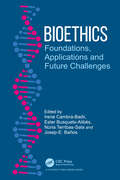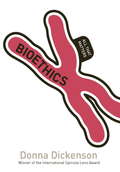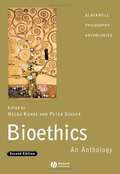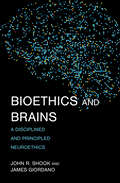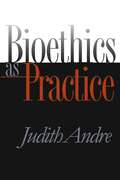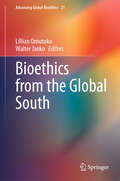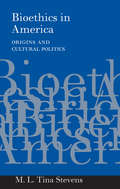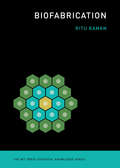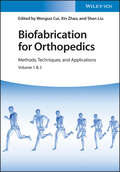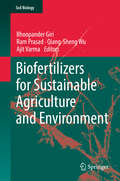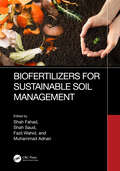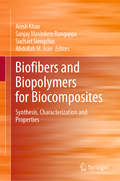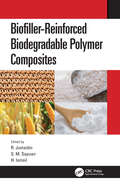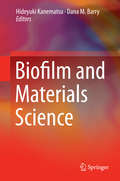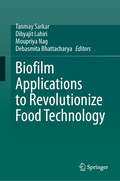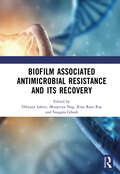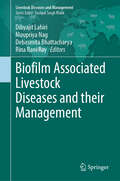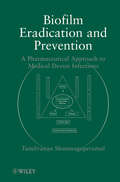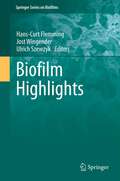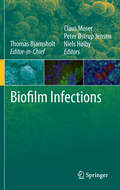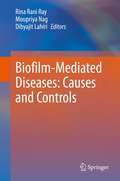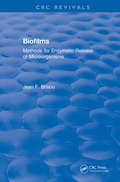- Table View
- List View
Bioethics: Foundations, Applications and Future Challenges
by Irene Cambra-Badii Ester Busquets-Alibés Terribas-Sala Núria Josep-E. BañosThe aim of this book is to introduce and discuss bioethics in a three-synergistic way: from the foundations to the current debates in relation to healthcare and social bioethics, and thereafter the possible future challenges. In this sense, the target audience can be from diverse disciplines: life and medical sciences, law, philosophy, psychology, and education. The book will be useful to high school students, in their first contacts with bioethics, college students, teachers and researchers, and the general public interested in these controversial debates of the past, present and future of bioethics.
Bioethics: All That Matters
by Donna DickensonIn this book:Donna Dickenson - Winner of the International Spinoza Lens AwardShould we do what ever science lets us do?Bioethics: All That Matters, new developments in biotechnology like genetics, stem cell research and artificial reproduction arouse both our greatest hopes and our greatest fears. Many people invest the new biotechnology with all the aspirations and faith once accorded to religious salvation. But does everyone benefit equally from scientific progress? Commercialised modern biomedicine runs the risk of exploiting vulnerable groups, from Indian 'surrogate' mothers to professional guinea pigs in drug research. Professor Dickenson argues that although we've entered new scientific territory, there's no need to jettison our existing moral sense. By discussing a range of real-life cases, she equips readers to make up their own minds on these important and controversial questions. Good science and good ethics needn't be contradictory.This accessible and concise book will appeal to both students and general readers, giving a fascinating introduction to a wide range of perspectives on Bioethics.All That Matters books:All books in the All That Matters series are written by world experts in their subject field. These experts work to distil a topic and get right to its heart, making the book accessible for both students and general readers. Each compelling book contains new and interesting perspectives and tells stories that matter.The Author:All That Matters - Interesting introductions to important issuesBooks on the following subjects are available from the All That Matters series: Muhammad, God, Water, Political Philosophy, Sustainability, Philosophy, Intelligence, Love, Russian Revolution, War, and Creativity.To find out more visit: www.allthatmattersbooks.com
Bioethics: An Anthology (Second Edition)
by Helga Kuhse Peter SingerThe expanded and revised edition of Bioethics: An Anthology is a definitive one-volume collection of key primary texts for the study of bioethics. Brings together writings on a broad range of ethical issues relating such matters as reproduction, genetics, life and death, and animal experimentation. Now includes introductions to each of the sections. Features new coverage of the latest debates on hot topics such as genetic screening, the use of embryonic human stem cells, and resource allocation between patients. The selections are independent of any particular approach to bioethics. Can be used as a source book to complement A Companion to Bioethics (1999).
Bioethics: An Introduction for the Biosciences
by Ben MephamBioethical issues remain front-page news, with debate continuing to rage over issues including genetic modification, animal cloning, and 'designer babies'. With public opinion often driven by media speculation, how can we ensure that informed decisions regarding key bioethical issues are made in a reasoned, objective way? Bioethics: An Introduction for the Biosciences offers a balanced, objective introduction to the field of bioethics, ideal for any biosciences student who is new to the subject. With a focus on developing the students' power of reasoning and judgement, the book presents different perspectives to common themes in an impartial way, fostering debate and discussion. The opening section, 'The Ethical Groundwork', introduces students to the nature of bioethics and ethical theory. The book goes on to lead students through a broad range of bioethical issues relating to people, animals, and food, before concluding with an overview of bioethics in practice. The current generation of students will become the next generation of decision makers. Bioethics: An Introduction for the Biosciences is the perfect introduction to a field with which every biosciences student should be familiar. Online Resource Centre The Online Resource Centre features: For registered adopters of the book: - Figures from the book in electronic format, ready to download For students: - A web link library and hyperlinked reference list, giving ready access to additional information sources; - Topical updates: extensive summaries of the latest developments in those topics covered in the book, ensuring that the reader can remain up-to-date at all times.
Bioethics and Brains: A Disciplined and Principled Neuroethics (Basic Bioethics)
by John R. Shook James GiordanoHow neuroethics can be increasingly relevant and informative for inclusive social policy and political discourse about brain science and technologies.Neuroethics, a field just over two decades old, addresses both ethical issues generated in and by brain sciences and the neuroscientific studies of moral and ethical thought and action. These foci are reciprocally interactive and prompt questions of how science and ethics can and should harmonize. In Bioethics and Brains, John R. Shook and James Giordano ask: How can the brain sciences inform ethics? And how might ethics guide the brain sciences and their real-world applications?The authors&’ structure for a disciplined neuroethics reconciles science and ethics by requiring ethical principles consistent with moral neuroscience and moral psychology. Their cosmopolitan perspective looks beyond Western theories toward a new metaethics for neuroethics and illustrates its approach in chapters that address the issues and approaches to questions and problems generated by the proliferation of neurotechnology in global contexts. Shook and Giordano posit that neuroethics can merge science and ethics toward establishing global consensus on guiding brain research, neurotechnological innovation, and grounding neurorights.
Bioethics as Practice
by Judith Andre<P>Those who work in bioethics and the medical humanities come from many different backgrounds, such as health care, philosophy, law, the social sciences, and religious studies. The work they do also varies widely: consulting on ethical issues in patient care, working with legislatures, dealing with the media, teaching, speaking, writing and more. <P>Writing as a participant in this developing field, Judith Andre offers a model to unify its diversity. Using the term "bioethics" broadly, to include all the medical humanities, she articulates ideals for the field, identifies its temptations and moral pitfalls, and argues for the central importance of certain virtues. Perhaps the most original of these is the virtue of choosing projects well, which demands not only broadening the field's focus but also understanding the forces that have kept it too narrow. Andre offers an imaginative analysis of the special problems presented by interdisciplinary work and discusses the intellectual virtues necessary for its success. She calls attention to the kinds of professional communities that are necessary to support good work. <P>The book draws from interviews with many people in the field and from the findings of social scientists. It includes the author's personal reflections, several extended allegories, and philosophical analysis. <P>Those who work in bioethics and the medical humanities come from many different backgrounds: health care, philosophy, law, social sciences, religious studies, and more. The work they do also varies widely. Writing as a participant in this developing field, Judith Andre offers a model to unify its diversity. Using the term "bioethics" broadly, to include all the medical humanities, she articulates ideals for the field, identifies its temptations and moral pitfalls, and argues for the central importance of certain virtues.-->
Bioethics from the Global South (Advancing Global Bioethics #21)
by Lillian Omutoko Walter JaokoThis book tackles complex global issues like vaccination, climate change, environmental ethics, embryo adoption, and surrogate motherhood viewed from the perspective of the global south. The COVID-19 pandemic has emphasized the need for addressing bioethical issues on a global scale, beyond national and regional boundaries. Challenges highlighted in the book include cultural differences, multi-pluralism, insufficient funding, and limited opportunities for awareness and provision of education in global bioethics, particularly in low and middle-income countries. The book employs universal and global bioethics frameworks, referencing the Universal Declaration of Human Rights and the UNESCO Universal Declaration on Bioethics and Human Rights. These documents, along with other international agreements and national constitutions were used to advocate for human dignity, health, and fundamental freedoms. Contributions from authors in Kenya, Uganda, and Nigeria provide valuable perspectives, making this book a must-read for ethicists, bioethicists, medical students, and healthcare workers with an interest in global bioethics.
Bioethics in America: Origins and Cultural Politics
by M. L. StevensIn Bioethics in America, Tina Stevens challenges the view that the origins of the bioethics movement can be found in the 1960s, a decade mounting challenges to all variety of authority. Instead, Stevens sees bioethics as one more product of a "centuries-long cultural legacy of American ambivalence toward progress," and she finds its modern roots in the responsible science movement that emerged following detonation of the atomic bomb.Rather than challenging authority, she says, the bioethics movement was an aid to authority, in that it allowed medical doctors and researchers to proceed on course while bioethicists managed public fears about medicine's new technologies. That is, the public was reassured by bioethical oversight of biomedicine; in reality, however, bioethicists belonged to the same mainstream that produced the doctors and researchers whom the bioethicists were guiding.
Bioethics, Public Moral Argument, and Social Responsibility (Routledge Annals of Bioethics)
by Nancy M. P. King Michael J. HydeBioethics, Public Moral Argument, and Social Responsibility explores the role of democratically oriented argument in promoting public understanding and discussion of the benefits and burdens of biotechnological progress. The contributors examine moral and policy controversies surrounding biomedical technologies and their place in American society, beginning with an examination of discourse and moral authority in democracy, and addressing a set of issues that include: dignity in health care; the social responsibilities of scientists, journalists, and scholars; and the language of genetics and moral responsibility.
Biofabrication (The MIT Press Essential Knowledge series)
by Ritu RamanHow engineered materials and machines powered by living biological cells can tackle technological challenges in medicine, agriculture, and global security.You are a biological machine whose movement is powered by skeletal muscle, just as a car is a machine whose movement is powered by an engine. If you can be built from the bottom up with biological materials, other machines can be as well. This is the conceptual starting point for biofabrication, the act of building with living cells--building with biology in the same way we build with synthetic materials. In this volume in the MIT Press Essential Knowledge series, Ritu Raman offers an accessible introduction to biofabrication, arguing that it can address some of our greatest technological challenges. After presenting the background information needed to understand the emergence and evolution of biofabrication and describing the fundamental technology that enables building with biology, Raman takes deep dives into four biofabrication applications that have the potential to affect our daily lives: tissue engineering, organs-on-a-chip, lab-grown meat and leather, and biohybrid machines. Organs-on-a-chip (devices composed of miniature model tissues), for example, could be used to test new medicine and therapies, and lab-grown meat could alleviate environmental damage done by animal farming. She shows that biological materials have abilities synthetic materials do not, including the ability to adapt dynamically to their environments. Exploring the principles of biofabrication, Raman tells us, should help us appreciate the beauty, adaptiveness, and persistence of the biological machinery that drives our bodies and our world.
Biofabrication for Orthopedics: Methods, Techniques and Applications
by Wenguo Cui Xin Zhao Shen LiuBiofabrication for Orthopedics A comprehensive overview of biofabrication techniques for orthopedics and their novel applications With an ever-increasing global population and the rise in the occurrence of orthopedic diseases amongst an aging population, it is essential for technological advances to meet this growing medical need. Orthopedic biofabrication is a cutting-edge field that seeks to produce novel clinical solutions to this mounting problem, through the incorporation of revolutionary technologies that have the potential to not only transform healthcare, but also provide highly automated and personalized patient solutions. With the advances in the discipline, there is a significant growing interest in biofabrication for orthopedics in research activity geared towards routine clinical use. Ideal for a broad readership amongst medical practitioners and scientists, Biofabrication for Orthopedics summarizes all aspects of the topic: detailed information on the technology, along with advanced developments, research progress, and future perspectives on biofabrication for orthopaedics—particularly on the potential applications for tissue engineering technologies. In doing so, the book describes the various biomaterials—natural and synthetic—use for orthopedics and discusses the many ways in which these materials can be used in all parts of the body. As such, it offers detailed information on a wide range of applications in the fields of biology and clinical and industrial manufacturing. Biofabrication for Orthopedics readers will also find: Insights into the applications of biofabrication technologies in various bodily functions Thorough discussion of different biofabrication techniques used in creating orthopedic products, like stereolithography, cell sheet and organ bioprinting, electrospinning, and microfluidics Discussion of a wide range of diverse functions, such as bone implants, skin regeneration, vascularization, meniscus remodeling, and more Biofabrication for Orthopedics is a useful reference for those in a variety of research fields like medical-related practitioners and scientists, materials science, medicine, and manufacturing, as well as the libraries who support them.
Biofertilizers for Sustainable Agriculture and Environment (Soil Biology #55)
by Bhoopander Giri Ram Prasad Qiang-Sheng Wu Ajit VarmaThis book provides a comprehensive overview of the benefits of biofertilizers as an alternative to chemical fertilizers and pesticides.Agricultural production has increased massively over the last century due to increased use of chemical fertilizers and pesticides, but these gains have come at a price. The chemicals are not only expensive; they also reduce microbial activity in agricultural soils and accumulate in the food chain, with potentially harmful effects for humans. Accordingly, it is high time to explore alternatives and to find solutions to overcome our increasing dependence on these chemicals.Biofertilizers, which consist of plant remains, organic matter and microorganisms, might offer an alternative. They are natural, organic, biodegradable, eco-friendly and cost-effective. Further, the microbes present in the biofertilizers are important, because they produce nutrients required for plant growth (e.g., nitrogen, phosphorus, potassium), as well as substances essential for plant growth and development (e.g., auxins and cytokinins). Biofertilizers also improve the physical properties, fertility and productivity of soil, reducing the need for chemical fertilizers while maintaining high crop yield. This makes biofertilizers a powerful tool for sustainable agriculture and a sustainable environment.The book covers the latest research on biofertilizers, ranging from beneficial fungal, bacterial and algal inoculants; to microbes for bioremediation, wastewater treatment; and recycling of biodegradable municipal, agricultural and industrial waste; as well as biocontrol agents and bio-pesticides. As such, it offers a valuable resource for researchers, academics and students in the broad fields of microbiology and agriculture.
Biofertilizers for Sustainable Soil Management
by Shah Fahad Shah Saud Fazli Wahid Muhammad AdnanThe alkaline calcareous nature, high pH, salinity, heavy metals pollution, and low organic matter content of soils in many parts of the world have diminished the soil fertility and made essential nutrients unavailable to crops. To cope with the poor availability of soil nutrients, improve soil health, and feed the fast-growing global population, the farming community is using millions of tons of expensive chemical fertilizers in their fields to maintain an adequate level of nutrients for crop sustainability as well as to ensure food security. In this scenario, the exploitation of biofertilizers has become of paramount importance in the agricultural sector for their potential role in food safety and sustainable crop production. Bearing in mind the key importance of biofertilizers, this book examines the role of biofertilizers in sustainable management of soil and plant health under different conditions of the changing climate. Finally, it provides a platform for scientists and academicians all over the world to promote, share, and discuss various new issues, developments, and limitations in biofertilizers, crops, and beneficial microbes. Salient Features: Mainly focuses on the role of biofertilizers in managing soils for improving crop and vegetable yields as a substitute for chemical fertilizers. Highlights the valuable information for the mechanism of action, factors affecting, and limitations of biofertilizers in the wider ecosystem. Presents a diversity of techniques used across plant science. Designed to cater to the needs of researchers, technologists, policy makers, and undergraduates and postgraduates studying in the fields of organic agriculture, soil microbiology, soil biology, soil fertility, and fertilizers. Addresses plant responses to biofertilizers.
Biofibers and Biopolymers for Biocomposites: Synthesis, Characterization and Properties
by Abdullah M. Asiri Anish Khan Suchart Siengchin Sanjay Mavinkere RangappaThis book summarizes recent developments in epoxy blends. It emphasizes new challenges for the synthesis, characterization, and properties of biofibers and biopolymers. It provides updates on all the important areas of biofibers and biopolymers in a comprehensive fashion, including synthesis, processing, characterisation and application. It provides a a one-stop reference for researchers and those working in industry and government. The book correlates macro, micro and nanostructure properties. Moreover, it provides cutting edge research from experts around the globe. The current status, trends, future directions and opportunities are discussed in detail, making the book also accessible for beginners to the subject and young researchers.
Biofiller-Reinforced Biodegradable Polymer Composites
by R. JumaidinPresenting a comprehensive overview of the field, Biofiller-Reinforced Biodegradable Polymer Composites examines biodegradable composites derived from biofiller and biodegradable polymers while providing critical information for efficient use of biocomposites developed from natural resources. Discusses advanced techniques for the use of both biofiller and biodegradable polymers as the matrix for composites. Highlights application of both natural fiber and natural matrix for composites in the development of environmentally friendly and sustainable materials. Introduces the basics of biocomposites, the processing and characteristics of new composite materials, and new combinations of composites such as soy protein and nanocellulose. Elaborates on the introduction of new materials to develop biodegradable polymers. This book has been written for researchers, advanced students, and professional engineers and materials scientists working in the area of bio-based polymers, natural fiber composites, and biocomposites.
Biofilm and Materials Science
by Hideyuki Kanematsu Dana M. BarryThis book explains the formation of biofilm on materials surfaces in an industrial setting. The authors describe new developments in understanding of biofilm formation, detection, and control from the viewpoint of materials science and engineering. The book details the range of issues caused by biofilm formation and the variety of affected industries.
Biofilm Applications to Revolutionize Food Technology
by Tanmay Sarkar Dibyajit Lahiri Moupriya Nag Debasmita BhattacharyaBiofilm Applications to Transform the Food Industry is a sweeping introduction to the world of biofilms, illuminating their potential to revolutionize the landscape of both food safety and culinary innovation. This groundbreaking work delves into the various methods through which biofilms improve quality and sensory aspects, while also enhancing overall safety and sustainability. At its core, this book addresses the preeminent challenge facing the food industry: how to optimize taste, enhance safety and extend shelf life without compromising nutritional value. It offers a dynamic blueprint for chefs, food scientists, and industry professionals to leverage biofilm usage, exploring cutting-edge techniques that revolutionize fermentation, flavor enhancement, and waste reduction. By decoding the intricate mechanisms of biofilm interactions, this work unveils solutions to persistent industry challenges, providing practical insights and strategies to elevate culinary experiences while meeting consumer demands for healthier, safer, and more flavorful foods. Biofilm Applications to Transform the Food Industry is an indispensable guide for culinary professionals, food technologists, and enthusiasts seeking to stay ahead in a rapidly evolving industry. It equips readers with the tools to navigate the complexities of biofilm applications, empowering them to innovate, create ethically sound products, and contribute to a more sustainable future. This title's relevance lies in its ability to bridge the gap between cutting-edge science and practical culinary applications, making it an essential resource for those passionate about shaping the future of food technology.
Biofilm Associated Antimicrobial Resistance and Its Recovery
by Dibyajit Lahiri Moupriya Nag Rina Rani Ray Sougata GhoshA biofilm is a collection of microbial cells that have adhered to biotic surfaces such as plant cuticles or animal epithelia, as well as abiotic surfaces such as rocky substratum or catheter exteriors. The life cycle of a microorganism includes the fundamental process of biofilm formation for survival in diverse and harsh environments since it is a protected mode of growth allowing colonisation of new habitats by dispersal of microbes from the microbial clusters. The biofilm bound microorganisms remain embedded in an extracellular polymeric matrix that protects the indwelling cells from surfactants, biocides, several invaders like protozoans, and defences offered by the hosts like phagocytic cells. The biofilm bound recalcitrant microbes induce chronic and nosocomial diseases, posing a serious threat to public health. It has been observed that various antimicrobial drugs are able to successfully remove the planktonic (freely suspended) states of microbes as compared to the sessile (substrate-bound) forms, thus resulting in the development of antimicrobial resistance. Modern pharmacological strategies targeting the biofilm matrix differ from the conventional methods of antibiotic usage. This includes the use of natural compounds such as plant bioactive molecules, antimicrobial peptides, green synthesised nanoparticles, or secondary metabolites from other organisms that not only prevent the rise of antimicrobial resistance but are also safe for the host tissues. Biofilm Associated Antimicrobial Resistance and Its Recovery provides a detailed and systematic review of alternative pharmacological developments in the field of biofilm research. Features: A narrative overview of the mechanism of biofilm formation and its role in the emergence of antimicrobial resistance. Recent research in the development of antibiofilm remedies involving biogenic compounds. Advancements in biofilm detection methodologies with cutting-edge technologies. This book serves as a resource for researchers who need to understand and analyze the progression of events during microbial biofilm formation, as well as design safer methodologies for its successful eradication. It may also be used as a textbook for a graduate level course in microbiology or microbial biotechnology.
Biofilm Associated Livestock Diseases and their Management (Livestock Diseases and Management)
by Dibyajit Lahiri Moupriya Nag Debasmita Bhattacharya Rina Rani RayThe book discusses biofilms and adherent communities of microorganisms that play a significant role in livestock-associated infections. It explores the characteristics, formation, and consequences of biofilms in various livestock species and explains their involvement in diseases like mastitis, Johne's disease, caseous lymphadenitis, and more. It also explains intricate aspects of biofilm-related challenges, such as virulence, antibiotic resistance, quorum sensing, and inter-species communication. The book then explores the strategies for combatting biofilm-associated infections, encompassing phytomedicines, novel antimicrobials, and nanomedicines. This book serves as a great resource for researchers, veterinary practitioners and students by addressing these critical issues and providing a comprehensive understanding of biofilm dynamics in livestock infections, fostering improved diagnosis and treatment methodologies.
Biofilm Eradication and Prevention
by Tamilvanan ShunmugaperumalBiofilm Eradication and Preventions presents the basics of biofilm formation on medical devices, diseases related to this formation, and approaches pharmaceutical researchers need to take to limit this problem. Split into three parts, the first deals with the development and characterization of biofilm on the surfaces of implanted or inserted medical devices. Questions as to why biofilms form over medical device surfaces and what triggers biofilm formation are addressed. In the second section, the author discusses biofilm-mediated chronic infections occurred in various organs (eyes, mouth, wounds) and pharmaceutical and drug delivery knowledge gained from research in these area. The third part explores pharmaceutical approaches like lipid-and polymer-based drug delivery carriers for eradicating biofilm on device-related infections. In addition, this section also explores the topic of novel small molecule (like iron and its complexes/metal chelators) and a quorum-sensing inhibitors to control medical biofilm formation.
Biofilm Highlights (Springer Series on Biofilms #5)
by Hans-Curt Flemming Jost Wingender Ulrich SzewzykLiving in biofilms is the common way of life of microorganisms, transiently immobilized in their matrix of extracellular polymeric substances (EPS), interacting in many ways and using the matrix as an external digestion and protection system. This is how they have organized their life in the environment, in the medical context and in technical systems - and has helped make them the oldest, most successful and ubiquitous form of life. In this book, hot spots in current biofilm research are presented in critical and sometimes provocative chapters. This serves a twofold purpose: to provide an overview and to inspire further discussions. Above all, the book seeks to stimulate lateral thinking.
Biofilm Infections
by Claus Moser Thomas Bjarnsholt Niels Høiby Peter Østrup JensenThis book will cover both the evidence for biofilms in many chronic bacterial infections as well as the problems facing these infections such as diagnostics and treatment regimes. A still increasing interest and emphasis on the sessile bacterial lifestyle biofilms has been seen since it was realized that that less than 0.1% of the total microbial biomass lives in the planktonic mode of growth. The term was coined in 1978 by Costerton et al. who defined the term biofilm for the first time.In 1993 the American Society for Microbiology (ASM) recognised that the biofilmmode of growth was relevant to microbiology. Lately many articles have been published on the clinical implications of bacterial biofilms. Both original articles and reviews concerning the biofilm problem are available.
Biofilm Matrix (Springer Series on Biofilms #13)
by Courtney ReichhardtThis book provides a comprehensive review of biofilm matrices. The main topics include an introduction to biofilm matrices and the range of biofilm matrix components (i.e., biofilm matrixome) as well as an overview of what is known about matrix structure, functionality, and regulation. Additional topics include recent progress in investigating the biofilm matrixome as well as challenges and outstanding questions and descriptions of the influence of matrix interactions on biofilm architecture and pathogen-host interactions. This book covers an important aspect of biofilm biology-microbial biofilm matrices. Microbes form multicellular aggregates called biofilms, in which microbial cells are encased in an extracellular matrix. This enables microbes to withstand harsh environmental conditions including antibiotic treatment. Biofilms are ubiquitous in the environment and can be both beneficial and harmful. For example, they can be used to clean up wastewater, but they also cause serious and chronic infections. It is estimated that over 80% of infections in the United States are biofilm-associated. Some examples of biofilm-involved infections include infections of implanted medical devices or artificial joints and also chronic infections of burns and wounds, including diabetic ulcers. When biofilms show up during infections or human health problems, they act very differently than planktonic bacteria. For example, biofilms can be ~1000-fold more tolerant of antibiotics than their planktonic counterparts. The biofilm matrix is thought to be a key part of why these bacterial infections are so difficult to treat. Biofilm matrix composition varies between bacterial strains and under different growth conditions. In general, the biofilm matrix is rich in biopolymers and can contain exopolysaccharides, proteins, extracellular DNA (or eDNA), and lipids. The biofilm matrix promotes attachment and structurally reinforces bacterial aggregates, preventing clearance by mechanical forces. The matrix can even block antibiotics from accessing the bacteria or prevent the host immune system from seeing the bacteria. The target audience of this book is both established biofilm researchers and those who are newly learning about biofilms and biofilm matrices.
Biofilm-Mediated Diseases: Causes and Controls
by Rina Rani Ray Moupriya Nag Dibyajit LahiriThis book reviews the current concepts in biofilm formation and its implications in human health and disease. The initial chapters introduce the mechanisms of biofilm formation and its composition. Subsequently, the chapters discuss the role of biofilm in acute and chronic infections. It also explores the pivotal role of both innate and adaptive immunity on the course of biofilm infection. In addition, the book elucidates the bacterial biofilm formation on implantable devices and the current approaches to its treatment and prevention. It analyzes the possible relationship between antimicrobial resistance and biofilm formation. Finally, the book also summarizes the current state-of-the-art therapeutic approaches for preventing and treating biofilms. This book is a useful resource for researchers in the field of microbiology, clinical microbiology, and also medical practitioners.
Biofilms: Methods for Enzymatic Release of Microorganisms (CRC Press Revivals)
by Jean F. BrisouThis text presents a new technique for detecting microorganisms, specifically bacteria found in all levels of the biosphere. It also discusses methods for enzymatic release of these microbes as well as their interactions in all ecosystems. Drawings and micrographs help to illustrate this concept.Part one is devoted to the mechanisms of adherence. The second part discusses microbial ecology and the bacterial population of tissues as well as both land and aquatic microbiocenoses in general. Part three specifically covers technique. What is known about the mechanisms of adherence justifies the choice of techniques suggested. Applications in areas such as nature, medicine, environmental hygiene and the food industry are discussed. The explanation of useful techniques, the author's research results, and practical application methods make this volume an essential reference tool for researchers, technicians and practitioners.
